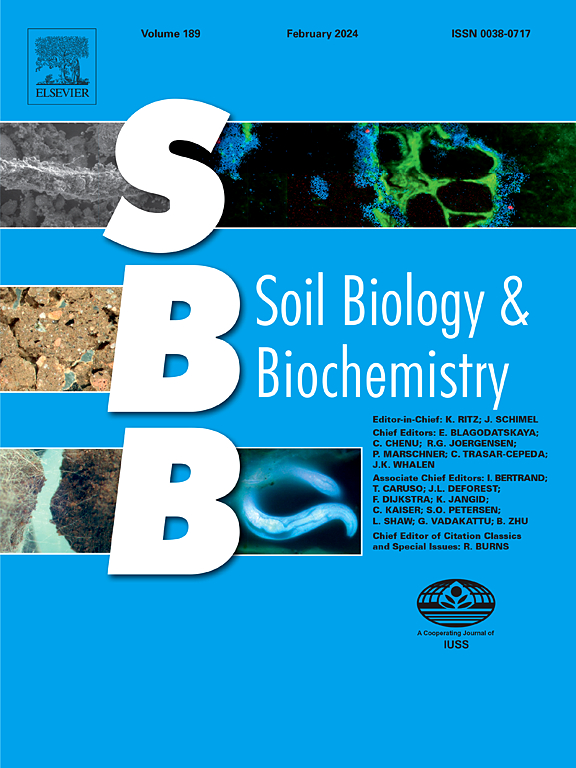Disentangling the contribution of mycorrhizal fungi to soil organic carbon storage
IF 10.3
1区 农林科学
Q1 SOIL SCIENCE
引用次数: 0
Abstract
Ectomycorrhizal fungi (ECM) play a fundamental role in plant-soil carbon and nitrogen cycling in forest ecosystems, yet their influence on soil organic carbon (SOC) sequestration remains underexplored, particularly in process-based models. Here, we develop a Mycorrhizal fungi-mediated Microbial-ENzyme Decomposition (Myc-MEND) model to explore ECM effects on plant carbon fixation and nitrogen uptake. The model was calibrated with biomass of foliage, wood, and roots, and annual net primary productivity from forests in eastern NC, USA. Our findings show that ECM enhance plant nitrogen availability, increasing plant productivity but not directly promoting SOC sequestration. We find that the increased nitrogen provided by ECM to plants decreased plant C:N ratio and led to a 17 % increase in plant photosynthate. This increase in plant quality and quantity increased SOC storage up to 20 %. However, these increases also stimulated saprotrophic microbial activity and extracellular enzyme production, resulting in a 14 % decline in SOC, particularly a 19 % reduction in the particulate organic carbon pool. The most influential pathway for SOC stability was the stabilization of recalcitrant mycorrhizal mycelium necromass, which accounts for 36 % of mineral-associated organic carbon (MOC) storage and 31 % of overall SOC accumulation. Although mycorrhizal colonization led to a net 14 % decrease in total SOC storage, it contributed to a 10 % increase in MOC, highlighting its role in enhancing MOC formation. Our simulations demonstrated that ECM influence the microbial carbon pump by lowering plant C:N ratios, reducing microbial carbon use efficiency, and altering plant-soil carbon fluxes. Overall, our results underscore the critical role of ECM in regulating microbial carbon pump mechanisms and their indirect contributions to SOC persistence via MOC formation. By bridging empirical observations and theoretical modeling, this study lays the groundwork for integrating mycorrhizae processes into future research aimed at predicting ecosystem carbon fluxes and assessing their climate change mitigation potential.
解菌根真菌对土壤有机碳储量的贡献
外生菌根真菌(ECM)在森林生态系统植物-土壤碳氮循环中发挥着重要作用,但其对土壤有机碳(SOC)固存的影响尚未得到充分研究,特别是在基于过程的模型中。在这里,我们建立了一个菌根真菌介导的微生物酶分解(Myc-MEND)模型来探索ECM对植物碳固定和氮吸收的影响。该模型以美国北卡罗来纳州东部森林的叶、木、根生物量和年净初级生产力为标准。研究结果表明,ECM提高了植物氮素利用率,提高了植物生产力,但没有直接促进有机碳的固存。我们发现,ECM向植物提供的氮增加,降低了植物C:N比,导致植物光合作用增加17%。这种植物质量和数量的增加使有机碳储存量增加了20%。然而,这些增加也刺激了腐坏营养微生物活动和细胞外酶的产生,导致SOC下降14%,特别是颗粒有机碳库减少19%。对有机碳稳定影响最大的途径是顽固菌根菌丝体坏死团的稳定,它占矿物相关有机碳(MOC)储量的36%和总有机碳积累的31%。虽然菌根定殖导致土壤有机碳总储量净减少14%,但其对MOC的贡献增加了10%,突出了其促进MOC形成的作用。我们的模拟表明,ECM通过降低植物碳氮比、降低微生物碳利用效率和改变植物-土壤碳通量来影响微生物碳泵。总的来说,我们的研究结果强调了ECM在调节微生物碳泵机制中的关键作用,以及它们通过MOC形成对有机碳持久性的间接贡献。通过将实证观察与理论建模相结合,本研究为将菌根过程整合到未来旨在预测生态系统碳通量和评估其减缓气候变化潜力的研究中奠定了基础。
本文章由计算机程序翻译,如有差异,请以英文原文为准。
求助全文
约1分钟内获得全文
求助全文
来源期刊

Soil Biology & Biochemistry
农林科学-土壤科学
CiteScore
16.90
自引率
9.30%
发文量
312
审稿时长
49 days
期刊介绍:
Soil Biology & Biochemistry publishes original research articles of international significance focusing on biological processes in soil and their applications to soil and environmental quality. Major topics include the ecology and biochemical processes of soil organisms, their effects on the environment, and interactions with plants. The journal also welcomes state-of-the-art reviews and discussions on contemporary research in soil biology and biochemistry.
 求助内容:
求助内容: 应助结果提醒方式:
应助结果提醒方式:


